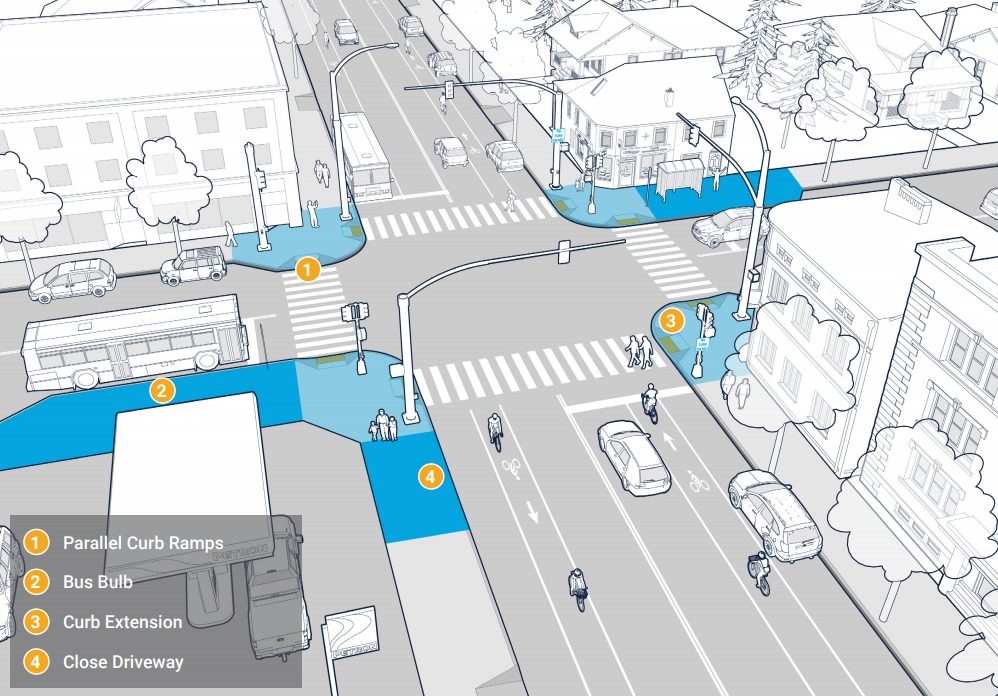Why City Pedestrian Plan Is Needed
Includes ways to improve pedestrian safety. Mayor and council should make this a priority.

Conceptual high impact redesign of N. 27th St. and W. Burleigh St. intersection in Milwaukee Pedestrian Plan.
On Thursday October 24th, a driver swerved around other vehicles on W. Center Street at N. 22nd Street, ran the red light, and struck three children who were walking home from a school playground. Two of the children, four- and six-year-old sisters, were killed, and their ten-year old cousin was seriously injured. This tragedy is far too familiar: more than 130 pedestrians have been killed and 560 seriously injured in Milwaukee during the last decade.
The latest horrific event was on Center Street, but there are dozens of streets in Milwaukee in which similar traffic conditions exist. We must act immediately to prevent more senseless loss of life.
As the universal form of human transportation, walking or traveling by wheelchair or other assistive device should be a fundamental right. Safe pedestrian travel is critical for neighborhood vitality, local business success, and community cohesion. Safe pedestrian travel should be the baseline goal for our transportation system. Milwaukee’s Complete Streets Policy, adopted a year ago, states that, “Above all, safety is imperative, with pedestrian safety having the highest priority…” It is clear that our community needs to step up and make pedestrian safety a priority.
In the days after the crash, the Mayor and Common Council petitioned Governor Tony Evers for additional resources to be directed to the Milwaukee Police Department for traffic enforcement to control reckless driving. Yet, traffic enforcement alone is inadequate to solve the pervasive problem of reckless driving that has become normalized in many parts of our community over the last several years. Standard safety tools, including speed limits and traffic signals, were insufficient to deter the unsafe driving behavior that led to the deaths on Center Street. Public health and public safety need to work together to implement creative strategies that increase pedestrian safety. This must include redesigning streets, another suggestion from city and county leaders that has received too little attention.
Embedded within this plan are several strategies that would make changes to our built environment in order to increase pedestrian safety. For example, curb extensions force behavior change among drivers by creating a barrier to drivers passing other cars on the right through intersections. Curb extensions also require drivers to slow down for cars in front of them that are waiting to turn left, make pedestrians more visible to drivers, and shorten pedestrian crossings. Good examples are found on parts of E. North Avenue, N. Downer Avenue, E. Brady Street, and W. Becher Street. Other strategies in the plan, such as lane reconfigurations, also help slow vehicle speeds and improve pedestrian safety. Examples include successful projects on S. 2nd Street, E. Locust Street, E. North Avenue, and N. Hawley Road. While some of these changes may cost drivers a few seconds of travel time, they will save lives. Many more of these pedestrian safety improvements are needed throughout the city.
Pedestrian safety is a right. All members of our community should be able to walk to and from work, school, and recreation without the risk of being injured or killed. In a city like ours in which reliable access to transportation is a concern for many, the importance of pedestrian safety is paramount. When we fail to ensure pedestrian safety, particularly in neighborhoods that are disproportionately impacted by other negative health and safety outcomes, we perpetuate health disparities. As experts in city planning and injury prevention and control, we demand faster progress to create safer streets for all, to prevent future tragedies, and to make Milwaukee a safer and healthier place to live.
Sara Kohlbeck, MPH, Assistant Director of the Comprehensive Injury Center at the Medical College of Wisconsin, Robert Schneider, PhD, Associate Professor in the Department of Urban Planning at the University of Wisconsin-Milwaukee, and Stephen Hargarten, MD, MPH, Director of the Comprehensive Injury Center at the Medical College of Wisconsin
Op-Ed
-
Wisconsin Candidates Decry Money in Politics, Plan to Raise Tons of It
 Dec 15th, 2025 by Ruth Conniff
Dec 15th, 2025 by Ruth Conniff
-
Trump Left Contraceptives to Rot; Women Pay the Price
 Dec 8th, 2025 by Dr. Shefaali Sharma
Dec 8th, 2025 by Dr. Shefaali Sharma
-
Why the Common Council’s Amended Budget is Good Policy for Milwaukee
 Nov 20th, 2025 by Alds. Marina Dimitrijevic and Russell W. Stamper, II
Nov 20th, 2025 by Alds. Marina Dimitrijevic and Russell W. Stamper, II





















Yes, yes, yes. Thank you!
This is great
Yes, this should definitely be a priority. For far too long, streets have been “Dangerous By Design” (see https://smartgrowthamerica.org/dangerous-by-design/). But key to this effort is this:
1) Traffic engineers must stop making these deadly designs so that rework like this isn’t necessary time and time again.
2) The persons responsible for making these dangerous designs should pay some money to fix their faulty (and deadly) work. If the people making these dangerous designs are held responsible, then perhaps they will stop making them.
3) There are many streets in Milwaukee which are too wide, the cars travel too fast, drivers ignore traffic laws, and pedestrians are ignored or killed. I hope this pedestrian plan can help address this.